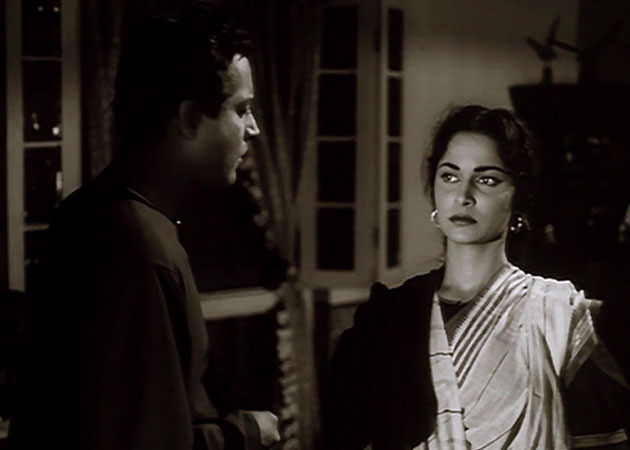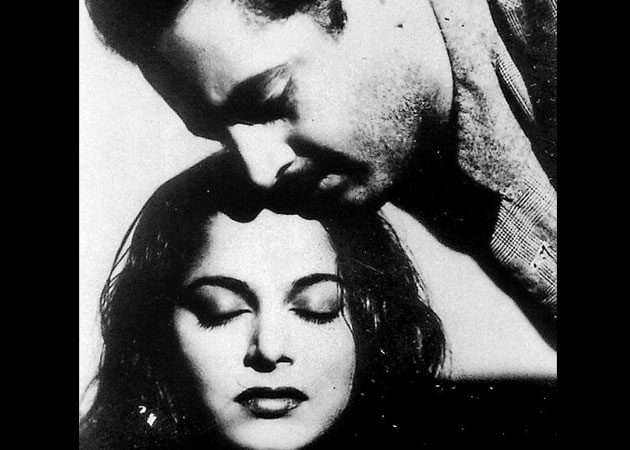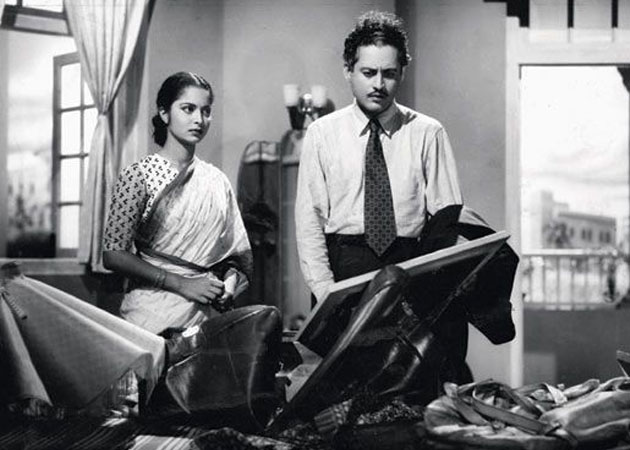
- As his countless fans remember him on his 87th birth anniversary, Guru Dutt's cinematic legacy continues to evoke interest in young directors who are looking up to the master story-teller for inspiration.
- Journalist-writer Sathya Saran believes that Guru Dutt will become even more important to filmmakers who are trying to break away from the formula.
- "I think there is a renewed interest in Guru Dutt. There are new kind of directors, who are looking at ways to break away from the formula and they are looking at blue prints. When you look at good cinema, Guru Dutt and Bimal Roy's films are obvious blue prints," said Saran, who wrote a book on Guru Dutt's long time friend and scriptwriter, Abrar Alvi.
- Director Tigmanshu Dhulia recently paid a tribute to Guru Dutt's Sahib, Bibi Aur Ghulam in Sahib, Bibi Aur Gangster, a modern retelling of the relationship between the man, woman and the servant.
- Sudhir Mishra, the director behind cult hits like Hazaaron Khwaishein Aisi, Dharavi and Chameli, counts Guru Dutt a huge influence.
- So does Anurag Kashyap, who had even planned to make a film on the filmmaker's troubled relationship with his wife Geeta Dutt and muse Waheeda Rehman.
- Guru Dutt, real name Vasanth Kumar Shivashankar Padukone, was born on July 9, 1925 in a Konkani Chitrapur Saraswat Brahmin family in Karnataka.
- He did not have a happy childhood as it was marked by financial difficulties, strained relationship between his parents and other problems, which would continue to haunt him throughout his life.
- The director, who often played lead roles in his films besides directing and producing, is famous for his lyrical use of camera. He mastered the extraordinary interplay of light and shadow, which became his signature style.
- Remembered most for his all-time classic Pyaasa, about a talented poet neglected by loved ones and society, Guru Dutt, by the end of his short but eventful career, stood as an icon.
- Pyaasa was named by 'Time' magazine as one of the 100 best films of all time a few years ago.
- Guru Dutt is often credited with ushering in the golden era of Hindi cinema with his classics.
- His film Kaagaz Ke Phool, semi-autobiographical and about the doomed relationship between a director and actress, was a huge commercial failure at the time of its release.
- The director, who had a devoted a lot of money and passion in the film, could never recover from its loss. He was so disappointed with its poor performance that he stopped directing films, fearing he was unlucky as a director.
- The film became a cult after his death and it remains one of his finest work.
- Though his style is very visible, the other films to come out from his production house were helmed by others.
- The cinema legend, who was found dead on October 10, 1964, suspected to be a suicide, was 39 when he died.
Did our AI summary help?
Let us know.
Mumbai:
As his countless fans remember himon his 87th birth anniversary, Guru Dutt's cinematic legacycontinues to evoke interest in young directors who are lookingup to the master story-teller for inspiration.
Journalist-writer Sathya Saran believes that Guru Duttwill become even more important to filmmakers who are tryingto break away from the formula.
"I think there is a renewed interest in Guru Dutt. Thereare new kind of directors, who are looking at ways to breakaway from the formula and they are looking at blue prints.When you look at good cinema, Guru Dutt and Bimal Roy's filmsare obvious blue prints," said Saran, who wrote a book on GuruDutt's long time friend and scriptwriter, Abrar Alvi.
Director Tigmanshu Dhulia recently paid a tribute to GuruDutt's Sahib, Bibi Aur Ghulam in Sahib, Bibi Aur Gangster,a modern retelling of the relationship between the man, womanand the servant.

Sudhir Mishra, the director behind cult hits likeHazaaron Khwaishein Aisi, Dharavi and Chameli, countsGuru Dutt a huge influence.
So does Anurag Kashyap, who had even planned to make afilm on the filmmaker's troubled relationship with his wifeGeeta Dutt and muse Waheeda Rehman.

Guru Dutt, real name Vasanth Kumar Shivashankar Padukone,was born on July 9, 1925 in a Konkani Chitrapur SaraswatBrahmin family in Karnataka.
He did not have a happy childhood as it was marked byfinancial difficulties, strained relationship between hisparents and other problems, which would continue to haunt himthroughout his life.
The director, who often played lead roles in his filmsbesides directing and producing, is famous for his lyrical useof camera. He mastered the extraordinary interplay of lightand shadow, which became his signature style.
Remembered most for his all-time classic Pyaasa, abouta talented poet neglected by loved ones and society, GuruDutt, by the end of his short but eventful career, stood as anicon.

Pyaasa was named by 'Time' magazine as one of the 100best films of all time a few years ago.
Guru Dutt is often credited with ushering in the goldenera of Hindi cinema with his classics.
His film Kaagaz Ke Phool, semi-autobiographical andabout the doomed relationship between a director and actress,was a huge commercial failure at the time of its release.

The director, who had a devoted a lot of money andpassion in the film, could never recover from its loss.He was so disappointed with its poor performance that hestopped directing films, fearing he was unlucky as a director.
The film became a cult after his death and it remains one ofhis finest work.
Though his style is very visible, the other films to comeout from his production house were helmed by others.
The cinema legend, who was found dead on October 10,1964, suspected to be a suicide, was 39 when he died.
Journalist-writer Sathya Saran believes that Guru Duttwill become even more important to filmmakers who are tryingto break away from the formula.
"I think there is a renewed interest in Guru Dutt. Thereare new kind of directors, who are looking at ways to breakaway from the formula and they are looking at blue prints.When you look at good cinema, Guru Dutt and Bimal Roy's filmsare obvious blue prints," said Saran, who wrote a book on GuruDutt's long time friend and scriptwriter, Abrar Alvi.
Director Tigmanshu Dhulia recently paid a tribute to GuruDutt's Sahib, Bibi Aur Ghulam in Sahib, Bibi Aur Gangster,a modern retelling of the relationship between the man, womanand the servant.

Sudhir Mishra, the director behind cult hits likeHazaaron Khwaishein Aisi, Dharavi and Chameli, countsGuru Dutt a huge influence.
So does Anurag Kashyap, who had even planned to make afilm on the filmmaker's troubled relationship with his wifeGeeta Dutt and muse Waheeda Rehman.

Guru Dutt, real name Vasanth Kumar Shivashankar Padukone,was born on July 9, 1925 in a Konkani Chitrapur SaraswatBrahmin family in Karnataka.
He did not have a happy childhood as it was marked byfinancial difficulties, strained relationship between hisparents and other problems, which would continue to haunt himthroughout his life.
The director, who often played lead roles in his filmsbesides directing and producing, is famous for his lyrical useof camera. He mastered the extraordinary interplay of lightand shadow, which became his signature style.
Remembered most for his all-time classic Pyaasa, abouta talented poet neglected by loved ones and society, GuruDutt, by the end of his short but eventful career, stood as anicon.

Pyaasa was named by 'Time' magazine as one of the 100best films of all time a few years ago.
Guru Dutt is often credited with ushering in the goldenera of Hindi cinema with his classics.
His film Kaagaz Ke Phool, semi-autobiographical andabout the doomed relationship between a director and actress,was a huge commercial failure at the time of its release.

The director, who had a devoted a lot of money andpassion in the film, could never recover from its loss.He was so disappointed with its poor performance that hestopped directing films, fearing he was unlucky as a director.
The film became a cult after his death and it remains one ofhis finest work.
Though his style is very visible, the other films to comeout from his production house were helmed by others.
The cinema legend, who was found dead on October 10,1964, suspected to be a suicide, was 39 when he died.

